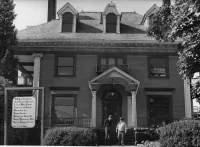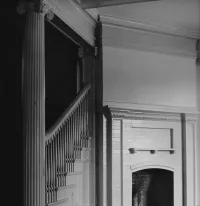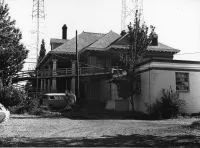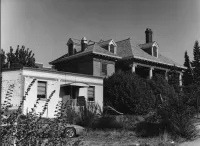Share what you know,
and discover more.
Share what you know,
and discover more.
Feb 08, 1980

-

- Charmaine Bantugan
National Register of Historic Places - Caroline Kline Galland House House
Statement of Significant: The original owner of the Caroline Kline Galland House was a noted benefactress of Seattle's Jewish community whose philanthropy is still an active force in the city today. The house itself is an example of Georgian Revival architecture in a locale which has lost most of the homes of comparable scale and finish formerly found there. Caroline Rosenberg was born in Bavaria, Germany, in 1841 and was first married to Louis Kline, head of a pioneer clothing firm in Seattle who died in 1892. Mrs. Kline was married to Bonham Galland, a retired merchant of San Francisco, the following year. In 1903 she commissioned architect Max Umbrecht to design her Seattle home, where she resided until her death on February 14, 1907. During her lifetime Mrs. Galland provided thousands of dollars in food, clothing, medical care, horses and wagons, and financial gifts to the poor. She left an estate of a million and a half dollars, chiefly derived from property in the central business district of Seattle, to continue the work after her death. The principal recipient was the Caroline Kline Galland Home for the Aged and Feeble Poor (operating today as the Galland Home for the Aged, 7500 Seward Park South, Seattle), which was established in accordance with the terms of her will for persons of the Jewish faith and members of the Society of Universal Religion. Existing charitable organizations of other creeds also received bequests. One of Seattle's wealthiest. citizens at the turn of the century, Mrs. Galland is remembered today for the philanthropy which motivated her to use her fortune in the service of others. The architect of the Caroline Kline Galland House, Max Umbrecht (1872-1955), was born in Syracuse, New York, where his immigrant grandfather was a bridge builder and his father a building contractor. The young Umbrecht learned architectural design through the apprentice system, including a period served with the firm of Merritt and Randall in New York City. His work thereafter was characterized by a preference for formal detail and balance and a use of large openings for maximum lighting. Umbrecht came to Seattle around 1900, concentrating his practice on private residences, including the one now used by Antioch College West at 1729 - 17th Avenue. He returned to Syracuse in 1922 and was active in architecture until his death. The Caroline Kline Galland House as built was a highly effective interpretation of the Georgian Revival mode. Its interior subsequently underwent considerable modification to meet the demands of office and multi-occupancy residential use in the years the property served as a health-care facility. However, the original char- acter will be retained or restored wherever possible in the current rehabilitation
National Register of Historic Places - Caroline Kline Galland House House
Statement of Significant: The original owner of the Caroline Kline Galland House was a noted benefactress of Seattle's Jewish community whose philanthropy is still an active force in the city today. The house itself is an example of Georgian Revival architecture in a locale which has lost most of the homes of comparable scale and finish formerly found there. Caroline Rosenberg was born in Bavaria, Germany, in 1841 and was first married to Louis Kline, head of a pioneer clothing firm in Seattle who died in 1892. Mrs. Kline was married to Bonham Galland, a retired merchant of San Francisco, the following year. In 1903 she commissioned architect Max Umbrecht to design her Seattle home, where she resided until her death on February 14, 1907. During her lifetime Mrs. Galland provided thousands of dollars in food, clothing, medical care, horses and wagons, and financial gifts to the poor. She left an estate of a million and a half dollars, chiefly derived from property in the central business district of Seattle, to continue the work after her death. The principal recipient was the Caroline Kline Galland Home for the Aged and Feeble Poor (operating today as the Galland Home for the Aged, 7500 Seward Park South, Seattle), which was established in accordance with the terms of her will for persons of the Jewish faith and members of the Society of Universal Religion. Existing charitable organizations of other creeds also received bequests. One of Seattle's wealthiest. citizens at the turn of the century, Mrs. Galland is remembered today for the philanthropy which motivated her to use her fortune in the service of others. The architect of the Caroline Kline Galland House, Max Umbrecht (1872-1955), was born in Syracuse, New York, where his immigrant grandfather was a bridge builder and his father a building contractor. The young Umbrecht learned architectural design through the apprentice system, including a period served with the firm of Merritt and Randall in New York City. His work thereafter was characterized by a preference for formal detail and balance and a use of large openings for maximum lighting. Umbrecht came to Seattle around 1900, concentrating his practice on private residences, including the one now used by Antioch College West at 1729 - 17th Avenue. He returned to Syracuse in 1922 and was active in architecture until his death. The Caroline Kline Galland House as built was a highly effective interpretation of the Georgian Revival mode. Its interior subsequently underwent considerable modification to meet the demands of office and multi-occupancy residential use in the years the property served as a health-care facility. However, the original char- acter will be retained or restored wherever possible in the current rehabilitation
Feb 08, 1980
National Register of Historic Places - Caroline Kline Galland House House
Statement of Significant:The original owner of the Caroline Kline Galland House was a noted benefactress of Seattle's Jewish community whose philanthropy is still an active force in the city today. The house itself is an example of Georgian Revival architecture in a locale which has lost most of the homes of comparable scale and finish formerly found there.
Caroline Rosenberg was born in Bavaria, Germany, in 1841 and was first married to Louis Kline, head of a pioneer clothing firm in Seattle who died in 1892. Mrs. Kline was married to Bonham Galland, a retired merchant of San Francisco, the following year. In 1903 she commissioned architect Max Umbrecht to design her Seattle home, where she resided until her death on February 14, 1907. During her lifetime Mrs. Galland provided thousands of dollars in food, clothing, medical care, horses and wagons, and financial gifts to the poor. She left an estate of a million and a half dollars, chiefly derived from property in the central business district of Seattle, to continue the work after her death. The principal recipient was the Caroline Kline Galland Home for the Aged and Feeble Poor (operating today as the Galland Home for the Aged, 7500 Seward Park South, Seattle), which was established in accordance with the terms of her will for persons of the Jewish faith and members of the Society of Universal Religion. Existing charitable organizations of other creeds also received bequests. One of Seattle's wealthiest. citizens at the turn of the century, Mrs. Galland is remembered today for the philanthropy which motivated her to use her fortune in the service of others.
The architect of the Caroline Kline Galland House, Max Umbrecht (1872-1955), was born in Syracuse, New York, where his immigrant grandfather was a bridge builder and his father a building contractor. The young Umbrecht learned architectural design through the apprentice system, including a period served with the firm of Merritt and Randall in New York City. His work thereafter was characterized by a preference for formal detail and balance and a use of large openings for maximum lighting. Umbrecht came to Seattle around 1900, concentrating his practice on private residences, including the one now used by Antioch College West at 1729 - 17th Avenue. He returned to Syracuse in 1922 and was active in architecture until his death.
The Caroline Kline Galland House as built was a highly effective interpretation of the Georgian Revival mode. Its interior subsequently underwent considerable modification to meet the demands of office and multi-occupancy residential use in the years the property served as a health-care facility. However, the original char- acter will be retained or restored wherever possible in the current rehabilitation
Posted Date
Jul 17, 2023
Historical Record Date
Feb 08, 1980
Source Name
National Register of Historic Places
Source Website
Delete Story
Are you sure you want to delete this story?














